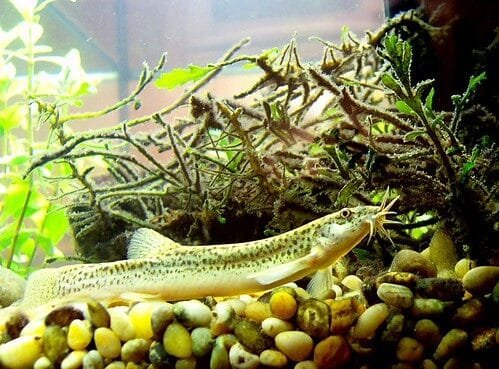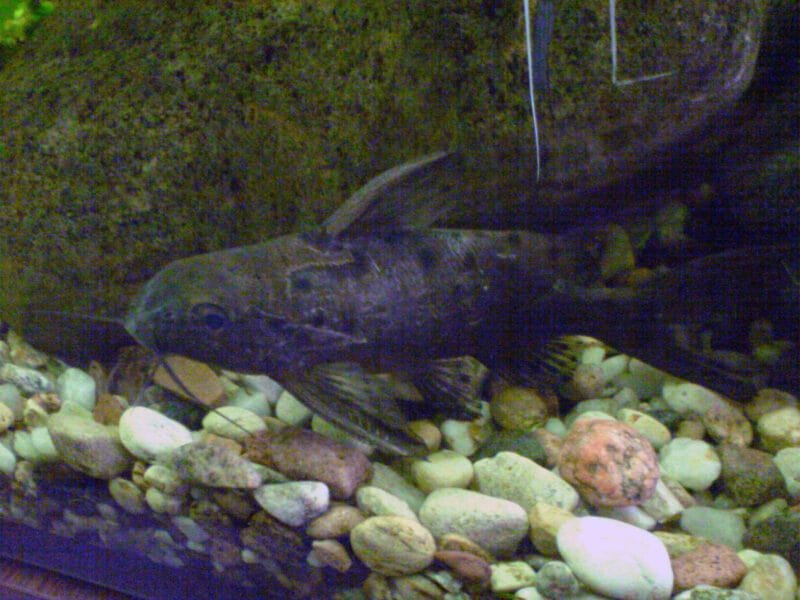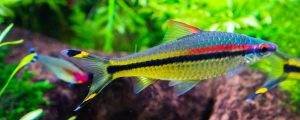The Shubunkin Goldfish (Carassius auratus) is a vibrant and hardy variety of goldfish celebrated for its stunning calico coloration and graceful swimming behavior. Originating in Japan in the early 1900s, this fish was selectively bred from the common goldfish to display a mix of metallic and matte colors, producing a mosaic of red, orange, white, blue, and black. Shubunkins are admired by aquarists for their beauty, resilience, and suitability for both aquariums and outdoor ponds.
Native Range and Origins
Although bred in Japan, the Shubunkin Goldfish descends from the wild Prussian carp found across East Asia. Its parent species, the Carassius auratus, was domesticated in China more than a thousand years ago and later introduced to Japan, where breeders developed the Shubunkin variety. Today, these fish are popular worldwide and are a staple in ornamental ponds and freshwater aquariums alike.
Physical Description and Size
Shubunkins are known for their elongated, streamlined bodies—similar to the common goldfish but enhanced by a spectacular patchwork of colors. Their scales often feature transparent edges, allowing their multi-colored patterning to show through vividly. Adult Shubunkins can grow up to 9–12 inches (23–30 cm) in aquariums, though they may reach 14 inches (35 cm) or more in outdoor ponds under ideal conditions.
Varieties of Shubunkin Goldfish
There are three recognized types of Shubunkin Goldfish, each distinguished by tail and body shape:
- London Shubunkin – Features a short, rounded tail and a compact body resembling the common goldfish.
- American (or Philadelphia) Shubunkin – Boasts a long, deeply forked tail similar to a comet goldfish.
- Bristol Shubunkin – Known for its distinct heart-shaped caudal fin and balanced proportions.
Diet and Feeding
Shubunkins are omnivorous and thrive on a varied diet. In captivity, they readily consume high-quality goldfish flakes or pellets. To maintain vibrant coloration and optimal health, supplement their diet with live or frozen foods such as bloodworms, daphnia, and brine shrimp, along with blanched vegetables like peas, spinach, and zucchini. Overfeeding should be avoided as goldfish are prone to digestive issues; feed small portions twice daily and ensure uneaten food is removed promptly.
Water Conditions and Tank Setup
Shubunkin Goldfish are coldwater species that prefer temperatures between 60–72°F (15–22°C), making them ideal for unheated aquariums or outdoor ponds. They require a spacious tank of at least 30 gallons for one fish, with an additional 10 gallons per extra Shubunkin. A powerful filtration system is essential, as goldfish are known for producing significant waste. Ensure good oxygenation with an air stone or gentle water movement. The ideal water parameters include a pH of 7.0–8.4 and moderate hardness.
Aquascaping and Substrate
Decorate their habitat with smooth gravel or rounded stones to prevent injury. Avoid sharp decorations, as Shubunkins are active swimmers and may scrape against rough surfaces. Live plants such as Anubias barteri or Amazon Sword can provide shade and natural oxygenation, though some may be uprooted by curious goldfish.
Temperament and Compatibility
Shubunkins are peaceful and sociable, making them excellent community fish when paired with other non-aggressive, similarly sized species. Ideal tank mates include other varieties of goldfish such as Common Goldfish, Koi Carp, or Golden Orfe (if in ponds). Avoid mixing them with tropical fish that require warmer temperatures or with aggressive species that might nip at their fins.
Sexing and Breeding
Sexing Shubunkins can be challenging outside the breeding season. Generally, males are slimmer and may develop small white tubercles on their gill covers and pectoral fins when ready to spawn. Females are rounder and broader when carrying eggs. Breeding typically occurs in spring as temperatures rise. The female scatters eggs among plants or spawning mops, which the male fertilizes externally. Parents may eat the eggs, so breeders often separate the adults after spawning. The fry hatch within 5–7 days and should be fed with infusoria or liquid fry food until large enough for crushed flakes or baby brine shrimp.
Ease of Care
One of the greatest appeals of the Shubunkin is its hardiness. These fish tolerate a wide range of water parameters and are resilient against common beginner mistakes, making them excellent for novice aquarists. Regular water changes—about 25% weekly—and consistent filtration maintenance are key to keeping them healthy and vibrant.
Albino Shubunkin
Albino Shubunkins are rare and visually striking variations featuring pale pink or white coloration and red eyes. They retain the same body shape and flowing fins but lack the traditional calico pattern. Due to reduced pigmentation, they may be slightly more light-sensitive, so ensure their aquarium provides shaded areas or floating plants. Care requirements are identical to the standard Shubunkin, and they can coexist peacefully with their colorful counterparts.
Common Health Concerns
Like other goldfish, Shubunkins may experience ailments such as ich, fin rot, and swim bladder issues. Maintaining good water quality, avoiding overfeeding, and performing regular tank maintenance are the best preventive measures. A quarantine period for new fish and plants also helps protect against parasites and disease.
Ideal Tank Mates
Shubunkins thrive in community tanks or ponds with other peaceful coldwater fish such as:
- Comet Goldfish
- Fantail Goldfish
- Oranda Goldfish
- Koi Carp
Avoid pairing with tropical species like guppies or tetras that prefer warmer water, or with fast or aggressive feeders that may outcompete them.
Related Species
Being a variant of the Carassius auratus species, the Shubunkin is closely related to other goldfish types such as the Common Goldfish, Oranda, and Fantail. Despite aesthetic differences, they share similar care requirements and are often crossbred to create new variations.
FAQs About the Shubunkin Goldfish
1. How big do Shubunkin Goldfish get?
In aquariums, they typically reach 9–12 inches, but in spacious outdoor ponds, they can grow even larger with proper diet and water quality.
2. Can Shubunkins live with Koi?
Yes, Shubunkins coexist well with Koi in ponds as both are coldwater fish that enjoy similar environments and diets.
3. Do Shubunkins need a heater?
No, they are coldwater fish and thrive in temperatures between 60–72°F (15–22°C). However, if the temperature drops below freezing in outdoor ponds, consider using a pond heater to prevent ice from completely sealing the surface.
Conclusion
The Shubunkin Goldfish is a dazzling, lively, and resilient member of the goldfish family, perfect for both aquariums and ponds. Its stunning coloration, peaceful temperament, and ease of care make it an enduring favorite among aquarists of all levels. Whether you’re a beginner seeking a low-maintenance pet or a seasoned hobbyist looking to enhance your pond’s visual appeal, the Shubunkin is a timeless choice that never fails to impress.






